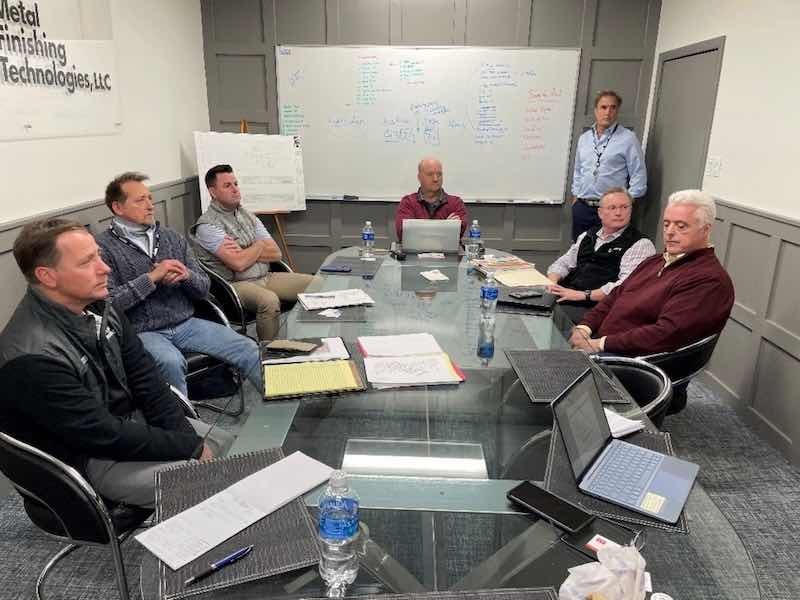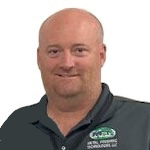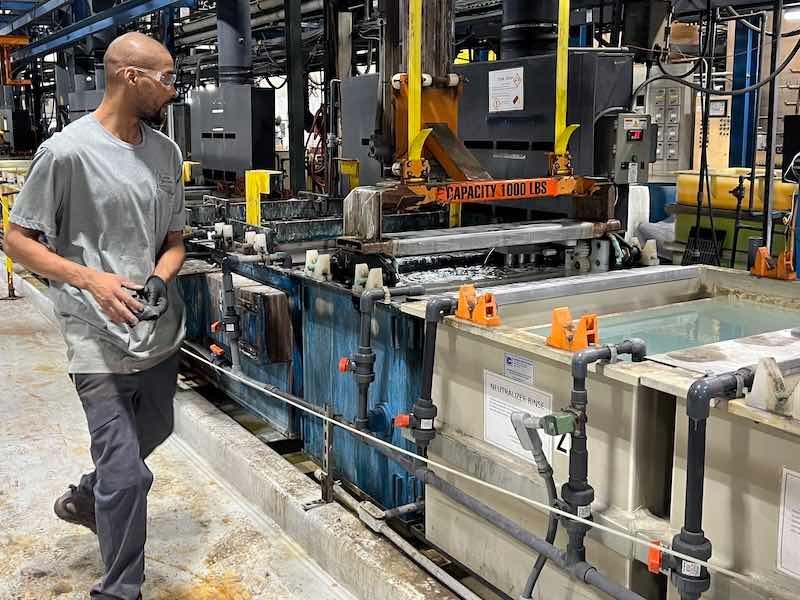A group of electroplaters in Connecticut are pioneering a new program to help recruit and train workers for their metal finishing facilities.
 George LaCapraMetal Finishing Technologies, UniMetal Surface Finishing, Summit Plating, American Electro Products, Waterbury Plating, Bass Plating, Har-Conn Metal Finishing, Whyco Finishing Technologies, and Pape Electroplating have formed the training consortium they call Master Electroplating Through Applied Learning, or METAL.
George LaCapraMetal Finishing Technologies, UniMetal Surface Finishing, Summit Plating, American Electro Products, Waterbury Plating, Bass Plating, Har-Conn Metal Finishing, Whyco Finishing Technologies, and Pape Electroplating have formed the training consortium they call Master Electroplating Through Applied Learning, or METAL.
Chemical manufacturers Hubbard-Hall and MacDermid Enthone Industrial Solutions —located in the Connecticut area — are also supporting the program, which is working with the Northwest Regional Workforce Investment Board to start classes in the Spring of 2024.
The course —free to students— will consist of 40 hours of classroom and hands-on training, with a job guaranteed at the successful end of the course. The shops involved in the METAL program need workers desperately to keep their operations running smoothly.
Shops Need to Hire Skilled Workers
 Metal Finishing Technologies, UniMetal Surface Finishing, Summit Plating, American Electro Products, Waterbury Plating, Bass Plating, Har-Conn Metal Finishing, Whyco Finishing Technologies, and Pape Electroplating have formed the training consortium they call Master Electroplating Through Applied Learning, or METAL.“It was important for us to create this now,” says George LaCapra Jr., President of UniMetal Surface Finishing. “The market needs skilled workers, and people are looking for ways to grow in their careers. The skills offered through this class are highly transferable and offer a career filled with technical growth in a fascinating, highly stable industry few know about.”
Metal Finishing Technologies, UniMetal Surface Finishing, Summit Plating, American Electro Products, Waterbury Plating, Bass Plating, Har-Conn Metal Finishing, Whyco Finishing Technologies, and Pape Electroplating have formed the training consortium they call Master Electroplating Through Applied Learning, or METAL.“It was important for us to create this now,” says George LaCapra Jr., President of UniMetal Surface Finishing. “The market needs skilled workers, and people are looking for ways to grow in their careers. The skills offered through this class are highly transferable and offer a career filled with technical growth in a fascinating, highly stable industry few know about.”
Peter Mirabello, Chairman and CEO of Metal Finishing Technologies, says it came down to thinking outside the box regarding workforce development, and he is excited to work with other shops from the finishing industry.
“It is just the headwind we're all facing,” Mirabello says of a shortage of available workers.
The idea for the partnership began over a year ago when Metal Finishing Technologies’ Vice President of Operations, Skip Griffin, recognized the need to broaden the appeal of working in the finishing industry. Mirabello says they would often get good workers from other sectors to join the company and wondered how they could improve the flow of new employees and train them before they started.
“We're getting some really good folks in the building, and they were from different walks of life,” Mirabello says. “It could be roofers, landscapers, or just people making a career change. And there was just a learning curve for them.”
Partnership in Training Potential Employees
 Peter MirabelloSince finishing skills are not taught in high school or trade programs, Griffin and Mirabello discussed seeing if they could use a training program.
Peter MirabelloSince finishing skills are not taught in high school or trade programs, Griffin and Mirabello discussed seeing if they could use a training program.
“We just couldn’t believe we couldn't find more people aware of this,” Mirabello says. “When we peeled the onion back a little bit further, we found out it was mostly because of the permits and the certificates and handling the sensitive materials that we take so seriously in these businesses. No one was going to take on that risk.”
That’s when Griffin and Mirabello approached the other plating shops in the Connecticut area and proposed a partnership to train potential employees. They were aware of trade groups that offered technical training but felt there needed to be some training in between to help employees when they first walked in the door.
“We felt those are a little too advanced for people just trying to either scope out the industry or just coming into the industry,” Griffin says. “Our pitch to selling this as a school was that we will do this at a very entry-level, basic understanding of finishing. Just skim the top, get people interested in plating, and then build from there.”
Connecticut has a large manufacturing base — one of the few states with a Chief Manufacturing Officer in the state government — with over 4,300 manufacturers based there, employing over 160,000 people. However, a recent survey by the state found that 87% of manufacturers there report difficulty finding or retaining employees, and 44% say the lack of skilled applicants is the greatest obstacle to growth.
Connecticut’s Goal to Increase Manufacturing Employment
 Skip GriffinPaul Lavoie, the Chief Manufacturing Officer for Connecticut, says the state’s Office of Manufacturing has set a goal of increasing manufacturing employment to 235,000 by 2033, a 4% annual increase. The state also wants to increase manufacturing’s annual gross domestic production by 7% to 20% by 2029.
Skip GriffinPaul Lavoie, the Chief Manufacturing Officer for Connecticut, says the state’s Office of Manufacturing has set a goal of increasing manufacturing employment to 235,000 by 2033, a 4% annual increase. The state also wants to increase manufacturing’s annual gross domestic production by 7% to 20% by 2029.
“I firmly believe manufacturing is a team sport,” Lavoie says. “We met with more than 130 manufacturers, held stakeholder focus groups, talked to trade associations, and connected with thousands working in the manufacturing ecosystem. We’ll continue to work with all our stakeholders as we implement our tactics, achieve our strategic initiatives, and hit our goals.”
That made the launch of METAL a perfect way for the finishing industry in the state to come together to take advantage of the state’s programs and training initiatives. They partnered with the Northwest Regional Workforce Investment Board — a primary convener of the manufacturing regional sector partnership —to help develop a solution to address the workforce challenges in metal finishing.
The training program could be a career opportunity for those looking to join the finishing industry.
An Opportunity to Grow a Career
 Ana Goncalves“If the participant has the right attitude and puts in the effort to combine the skills taught at METAL, they will be given the opportunity to grow their career,” says Catherine Awwad, President and CEO of the NRWIB.
Ana Goncalves“If the participant has the right attitude and puts in the effort to combine the skills taught at METAL, they will be given the opportunity to grow their career,” says Catherine Awwad, President and CEO of the NRWIB.
The course outline has been drafted and will be updated as the beginning of the coursework begins. So far, the syllabus includes:
- Part I. Introduction — 4 hours: The history of electroplating; a look at career paths and upsides of the industry; the challenges and opportunities: the billion-dollar finishing industry is not going away.
- Part II. Prerequisites — 3 hours: Basics of safety; Basics of LEAN manufacturing; Basics of business.
- Part III. Basics of Metal Finishing — 24 hours (Includes hands-on training): Part use/ what is being plated; identifying base metals and why certain metals are used, such as brass, copper, bronze, steel, stainless steel, aluminum, plus an introduction to the alloys; What is plating, and why plate? Heat treating, why and when to use it; Part handling/geometry and what to look for; Pretreatment, cleaning and activating, and de-burring; electroplating and post-plate processing.
- Part IV. Critical Support Functions — 8 hours: Waste treatment; inspection and quality assurance; testing laboratories; and environmental sustainability
- Part V. Certifications — 1 hour: CEF, OSHA 10, and LEAN
- Part VI. Benefits — 2 hours: Financial Wellness from Thomaston Bank; health care; and community involvement with local charities and other organizations.
Ana Goncalves, the Director of Strategic Planning and Development for NRWIB, says they have been bidding for a provider to complete the curriculum and deliver the coursework.
“We are procuring curriculum development specialists purposely for this course,” she says. “We need to put the lessons into a deliverable format and trademark it; we want the curriculum to be ours, and we want ownership of it.”
Recruiting Instructors From the Industry
 UniMetal's Patrick Hayden leads a meeting of the group Master Electroplating Through Applied Learning, or METAL.Goncalves says NRWIB is the course's facilitator but that the finishing industry needs to drive the agenda for the overall program. The METAL companies are working to recruit instructors from the industry to teach the course.
UniMetal's Patrick Hayden leads a meeting of the group Master Electroplating Through Applied Learning, or METAL.Goncalves says NRWIB is the course's facilitator but that the finishing industry needs to drive the agenda for the overall program. The METAL companies are working to recruit instructors from the industry to teach the course.
She says having so many competitors in one industry, such as finishing, come together for this program is extremely rare.
“This is absolutely unique,” Goncalves says. “They don't typically come together and help each other fix workforce issues. But it is about removing that competitiveness out of the engagement for the betterment of manufacturing overall.”
LaCapra says Unimetal is focusing more on employee engagement and creating a sustainable culture for the long term, which includes making employees feel that they are a valuable part of the business.
“We've increased wages, and we have more employee engagement participation inside and outside of work,” LaCapra says. “And that’s also then holding them to higher standards of behavior. I think that's key when you have those elements, and it makes for a successful culture and creates an environment where they want to come to work.”
Patrick Hayden, Senior Vice President, and Chief Technology Officer at UniMetal, says their company has brought on more managers and directors to help run the company as it has grown over the years since the merger of two Connecticut finishing operations in 2011, which raised their staffing to 130 people.
“It's a much bigger company, and we have done a wonderful job bringing on a new HR director, a CFO, and people that can give us better visions and understanding than when we were as small, independent business owners as we were years ago,” Hayden says. “It's nice to have people with talents that make it easier to present things to you that help you move in the proper directions.”
Possibly Offering More Advanced Classes
 METAL members meet at UniMetal's offices to discuss curriculum for the electoplating coursework.The initial coursework aims to offer more advanced classes that fall in between onboarding and what trade associations offer. A few examples of possible courses are basic chemistry for electroplaters, preparing metals for plating, acids and activation, barrel and rack plating technology, understanding titration, optimizing rinsing, need for filtration, the use of hull cells to troubleshoot, commonly plated alloys, the difference between anodizing and plating, and common finishes such as zinc, electroless nickel, cadmium, chrome, silver, and passivates.
METAL members meet at UniMetal's offices to discuss curriculum for the electoplating coursework.The initial coursework aims to offer more advanced classes that fall in between onboarding and what trade associations offer. A few examples of possible courses are basic chemistry for electroplaters, preparing metals for plating, acids and activation, barrel and rack plating technology, understanding titration, optimizing rinsing, need for filtration, the use of hull cells to troubleshoot, commonly plated alloys, the difference between anodizing and plating, and common finishes such as zinc, electroless nickel, cadmium, chrome, silver, and passivates.
Griffin says he hopes the course will provide viable employment candidates with immediate familiarity with the industry so that employees don’t have to wait 30-60-90 days of trial to see if they like the work.
“When we bring somebody on, they don't typically come in with any experience,” Griffin says. “It’s just like if you have anybody in this industry that applies with experience, you hire them whether you're hiring or not. You'll find a spot for them.”
He says Metal Finishing Technologies’ experience is that it takes 90 to 180 days to determine if the hired person will stay with the position and “down the road be a true plater, finisher, racker, master, or whatever they turn out to be.”
On the business's quality control, inspection, and laboratory side, Griffin says the idea is to attract people looking for a career.
“We're not looking for people that just want a job for a little bit,” he says. “We're looking for people that are looking for a career, and there's plenty of room for advancement in this industry.”
Griffin says that when he joined the finishing industry in 1988, he was one of the youngest working in it when he went to regional and national conferences.
“Until a few years ago, I was still one of the youngest guys in the industry,” he says. “We hadn’t backfilled very well, but that is changing, and it's changing dramatically. I'm seeing a lot more as I go to these conferences and seminars and a lot more younger people coming in.”
Understand the Fundamentals of Finishing Business
Mirabello says it is also important for new employees to understand the fundamentals of the finishing business from the start of their employment, especially the emphasis on quality and satisfying customers.
“Make no mistake about it, our businesses make money on the floor of the shop with the parts that we produce,” he says. “If you understand how a business works and makes money, then you become valuable to that business.”
The companies who have formed METAL hope that the education program changes how potential employees see the finishing industry as a career option.
“Usually, their first day of learning about plating is the first day of showing up at a new job,” Griffin says. “It's not a CEF course that's way too advanced for an entry-level person. This will set the baseline understanding with some hands-on experience that is critical because they will see an unfinished part get finished, and that is pretty satisfying to most people.”
Top image courtesy of Plation Solutions.



































